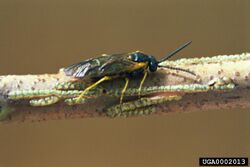Biology:Heteroperreyia hubrichi
| Heteroperreyia hubrichi | |
|---|---|

| |
| Female Heteroperreyia hubrichi, guarding her eggs | |
| Scientific classification | |
| Kingdom: | Animalia
|
| Phylum: | |
| Class: | |
| Order: | |
| Family: | |
| Subfamily: | |
| Genus: | Heteroperreyia
|
| Species: | H. hubrichi
|
| Binomial name | |
| Heteroperreyia hubrichi Malaise, 1937
| |
Heteroperreyia hubrichi is a South American sawfly that feeds on plants of the genus Schinus.[1]
Role in biological control
Brazilian pepper trees (Schinus) are trees native to South America, whose ornamental introduction lead to a process of biological invasion in more than 20 countries.[2] In US states of Florida and Hawaii, the introduction of the sawfly H. hubrichi was proposed as a controlling mechanism against the Brazilian pepper tree's dispersion, due to the high host specificity it shows.[3][4] In Florida, host-specificity tests with commercially valuable and native/endangered tree species were conducted and were positive, so a request to the technical advisory group on the Introduction of Biological Control Agents of Weeds about the introduction was approved, however, as H. hubrichi is known to produce cytotoxic peptides as do other pergid sawflies,[5][6][7] concern about cattle intoxication probably stopped it.[8][9] Results in Hawaii showed potential risk to endangered Rhus sandwicensis.[3]
References
- ↑ "The biology of perreyiine sawflies (Hymenoptera: Pergidae) of the Perreyia genus-group.". Hymenoptera: evolution, biodiversity and biological control. Fourth International Hymenoptera Conference, held in Canberra, Australia, in January 1999.. Collingwood, Australia: CSIRO Publishing. 2000. pp. 258–266.
- ↑ "Megastigmus seed wasp damage on native Schinus terebinthifolia drupes in ecological restoration area in Brazil". Scientific Reports 9 (1): 2438. February 2019. doi:10.1038/s41598-019-39129-x. PMID 30792467. Bibcode: 2019NatSR...9.2438G.
- ↑ 3.0 3.1 "Biology, host specificity tests, and risk assessment of the sawfly Heteroperreyia hubrichi, a potential biological control agent of Schinus terebinthifolius in Hawaii" (in en). BioControl 48 (4): 461–476. 2003-08-01. doi:10.1023/A:1024734508842. ISSN 1573-8248.
- ↑ "Host Specificity ofHeteroperreyia hubrichiMalaise (Hymenoptera: Pergidae), a Potential Biological Control Agent of Brazilian Peppertree (Schinus terebinthifoliusRaddi)" (in en). Biological Control 14 (1): 60–65. January 1999. doi:10.1006/bcon.1998.0670.
- ↑ Williams, Dudley H.; Santikarn, Sitthivet; De Angelis, Francesco; Smith, Richard J.; Reid, David G.; Oelrichs, Peter B.; MacLeod, John K. (1983). "The structure of a toxic octapeptide from the larvae of sawfly". Journal of the Chemical Society, Perkin Transactions 1: 1869. doi:10.1039/p19830001869.
- ↑ "Unique toxic peptides isolated from sawfly larvae in three continents" (in en). Toxicon 37 (3): 537–544. March 1999. doi:10.1016/S0041-0101(98)00192-5. PMID 10080356.
- ↑ "Toxic peptides occur frequently in pergid and argid sawfly larvae". PLOS ONE 9 (8): e105301. 2014-08-14. doi:10.1371/journal.pone.0105301. PMID 25121515. Bibcode: 2014PLoSO...9j5301B.
- ↑ "Biological Control of the Invasive Weed Schinus terebinthifolia (Brazilian Peppertree): A Review of the Project with an Update on the Proposed Agents" (in en). Southeastern Naturalist 15 (sp8): 15–34. December 2016. doi:10.1656/058.015.sp802.
- ↑ "Brazilian peppertree sawfly larvae toxicity in bovines.". Veterinary Clinical Pathology 33: 191. November 2004.
Wikidata ☰ Q65070938 entry
 |


